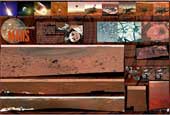
 |
|
|
|
In his introduction to this new edition of his 1993 opus, John North states that very few cultures have been ignored. In my opinion, not one has been ignored. This vast volume takes the story of astronomy from pre-historic years through to 2005 and the results from the Cosmic Background Explorer (COBE) and Hubble Space Telescope. The book avoids dismissal of astrology but moreover gives this matter a credible airing. It brings together a compendium of evidence from all corners of the globe. There are fascinating examples contained within 12 chapters such as the astronomy of China, Japan and pre-Columbian America; and mention should be made of the astronomy of Eastern and Western Islam, which has European crossovers. All the great astronomers are here, from Copernicus, Kepler and Galileo to Newton, Halley and Herschel, not forgetting Bessel, Hale and Hubble to name but a few. I am particularly impressed by North’s address of Ptolemy, which links Greek and Roman astronomy. The basis of Ptolemy’s work lay with Hipparchus’ enquiries of the Sun’s motion and positioning. North is quick to draw on Hipparchus’ mathematical equations resulting from use of equipment such as the eccentric and epicycle to provide an important background. Ptolemy’s subsequent discovery was that in order to determined the correct position of the Sun, two angles are required to form a parallax. North investigates the full range of Ptolemy’s pioneering astronomy and should be commended in this regard. Another highlight is North’s comparison work. Chapter 20, pages 749–750, has a list of stars at different stages of their lives as perceived in 1970. His selections are given the ‘before and after’ treatment and it is this quality that underpins the whole book – the definitive story of the evolution of cosmology. As a central theme, the book wins and North’s inclusion of diagrams and images illuminates the text throughout. As the twentieth century merges into the new millennium with the new satellite astronomy from Earth’s orbit coming into its own, the book’s pace remains suitably calm in order for the reader to take account of all the detail. The biographical notes are useful but I would have preferred the author to have referenced his evidence on the page with an extensive list of sources at the end of each chapter. The author is very precise regarding signposting of discoveries and dates so even more reason for accurate referencing. This recommendation in no way detracts from the book being an excellent survey told in a very readable tone. Ian Welland |
|
|
|
2009 Yearbook This 132-page special edition features the ultimate observing guide for 2009, a review of all the biggest news stories of 2008, in depth articles covering all aspects of astronomy and space missions for 2009, previews of International Year of Astronomy events and much, much more. This 132-page special edition features the ultimate observing guide for 2009, a review of all the biggest news stories of 2008, in depth articles covering all aspects of astronomy and space missions for 2009, previews of International Year of Astronomy events and much, much more.Infinity Rising  This special publication features the photography of British astro-imager Nik Szymanek and covers a range of photographic methods from basic to advanced. Beautiful pictures of the night sky can be obtained with a simple camera and tripod before tackling more difficult projects, such as guided astrophotography through the telescope and CCD imaging. This special publication features the photography of British astro-imager Nik Szymanek and covers a range of photographic methods from basic to advanced. Beautiful pictures of the night sky can be obtained with a simple camera and tripod before tackling more difficult projects, such as guided astrophotography through the telescope and CCD imaging.Exploring Mars  Astronomy Now is pleased to announce the publication of Exploring Mars. The very best images of Mars taken by orbiting spacecraft and NASA's Spirit and Opportunity rovers fill up the 98 glossy pages of this special edition! Astronomy Now is pleased to announce the publication of Exploring Mars. The very best images of Mars taken by orbiting spacecraft and NASA's Spirit and Opportunity rovers fill up the 98 glossy pages of this special edition!Mars rover poster  This new poster features some of the best pictures from NASA's amazing Mars Exploration Rovers Spirit and Opportunity. This new poster features some of the best pictures from NASA's amazing Mars Exploration Rovers Spirit and Opportunity. |
||||||||||||||||||||||||